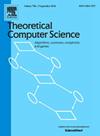G-good-neighbor diagnosability under the modified comparison model for multiprocessor systems
IF 0.9
4区 计算机科学
Q3 COMPUTER SCIENCE, THEORY & METHODS
引用次数: 0
Abstract
Diagnosing faults in multiprocessor systems has long been significant due to its performance impact and its blend of Graph Theory and Computer Science concepts. In 2012, Peng et al. introduced the g-good-neighbor diagnosability, ensuring every fault-free node has at least g fault-free neighbors. This concept, gaining traction over the years, has led to extensive research on the connectivity and diagnosability of many prominent multiprocessor systems. In this paper, we introduce a novel comparison model, the MC model, for multiprocessor systems. This model integrates the strengths of both the PMC and MM⁎ models, optimizing computing power and time. We present an algorithm detailing the MC model's operations and establish the conditions for a multiprocessor system G to be g-good-neighbor t-diagnosable under the MC model. A general method to determine a G's g-good-neighbor diagnosability under the MC model is also provided. We further highlight the MC model's advantages over the PMC and MM (including MM⁎) models. Lastly, we apply the MC model to Hypercube, determining its g-good-neighbor diagnosability.
求助全文
约1分钟内获得全文
求助全文
来源期刊

Theoretical Computer Science
工程技术-计算机:理论方法
CiteScore
2.60
自引率
18.20%
发文量
471
审稿时长
12.6 months
期刊介绍:
Theoretical Computer Science is mathematical and abstract in spirit, but it derives its motivation from practical and everyday computation. Its aim is to understand the nature of computation and, as a consequence of this understanding, provide more efficient methodologies. All papers introducing or studying mathematical, logic and formal concepts and methods are welcome, provided that their motivation is clearly drawn from the field of computing.
 求助内容:
求助内容: 应助结果提醒方式:
应助结果提醒方式:


